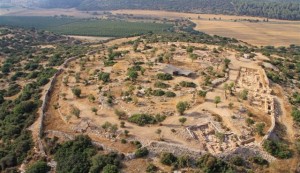Rough Times for Biblical Minimalists
 Recently, there’s been a struggle between the so-called Biblical “minimalists” and the Biblical “maximalists”. The latter believe that the Bible records accurate history. The former believe that the Biblical narrative is fiction, myth and/or propaganda. The minimalists come in at least two varieties. Outside of Israel, they mix their minimalism with anti-Israel venom claiming that modern Zionists forged Israel’s past so they could steal land from the Palestinians. Inside of Israel, the minimalists don’t mix anti-Semitism with the rhetoric. Largely centered around Tel Aviv University, they pretty much accept the Biblical narrative from the 8th century BC onwards. But everything before; including King David and his son King Solomon, the period of the Judges, the conquest of Israel and the Biblical Exodus they regard as fantasy. For them, “scientific” methodology means ignoring the Bible. They dig in a vacuum and they try to reconstruct history from potsherds without any references to texts. Led by people such as Professor Israel Finkelstein of Tel Aviv University, they have argued that King David never existed and that his fabled kingdom is a fairytale. They base this on the idea that there are no “monumental” structures dated to King David’s time i.e., the 10th century BCE. Great kingdoms, they say, leave behind great structures. If he existed he should have left behind evidence of a monumental nature. But he did, say the Biblical maximalists. In places like Hazor, Gezer and Megiddo there are monumental gates attesting to a centralized and far reaching administration. But here is where the minimalists play the “dating” game; show them a great building and they’ll date it later than David, based on the flimsiest evidence e.g., the type of grooves seen on the monumental stones. But, now, the minimalists are on the run.
Recently, there’s been a struggle between the so-called Biblical “minimalists” and the Biblical “maximalists”. The latter believe that the Bible records accurate history. The former believe that the Biblical narrative is fiction, myth and/or propaganda. The minimalists come in at least two varieties. Outside of Israel, they mix their minimalism with anti-Israel venom claiming that modern Zionists forged Israel’s past so they could steal land from the Palestinians. Inside of Israel, the minimalists don’t mix anti-Semitism with the rhetoric. Largely centered around Tel Aviv University, they pretty much accept the Biblical narrative from the 8th century BC onwards. But everything before; including King David and his son King Solomon, the period of the Judges, the conquest of Israel and the Biblical Exodus they regard as fantasy. For them, “scientific” methodology means ignoring the Bible. They dig in a vacuum and they try to reconstruct history from potsherds without any references to texts. Led by people such as Professor Israel Finkelstein of Tel Aviv University, they have argued that King David never existed and that his fabled kingdom is a fairytale. They base this on the idea that there are no “monumental” structures dated to King David’s time i.e., the 10th century BCE. Great kingdoms, they say, leave behind great structures. If he existed he should have left behind evidence of a monumental nature. But he did, say the Biblical maximalists. In places like Hazor, Gezer and Megiddo there are monumental gates attesting to a centralized and far reaching administration. But here is where the minimalists play the “dating” game; show them a great building and they’ll date it later than David, based on the flimsiest evidence e.g., the type of grooves seen on the monumental stones. But, now, the minimalists are on the run.
Israeli archaeologists Yossi Garfinkel of the Hebrew University and Saar Ganor of the Israel Antiquities Authority have announced the discovery of two monumental buildings just outside of Jerusalem at a site that is suspected to be the Biblical Shaarayim. Dated to the 10th century BCE, it may very well be the smoking gun evidence that proves that King David is no myth. This comes on the heels of the discovery of a palace in the oldest part of the city of Jerusalem (Ir David) by Israeli archaeologist Eilat Mazar.
It’s a sad day for the minimalists and it proves that you can’t do archaeology in a vacuum. It’s not “scientific” to ignore the Biblical texts. Science requires that we match texts to finds and let the potsherds fall where they may.

![image004[1]](http://www.simchajtv.com/wp-content/uploads/2013/07/image0041-300x229.jpg)
